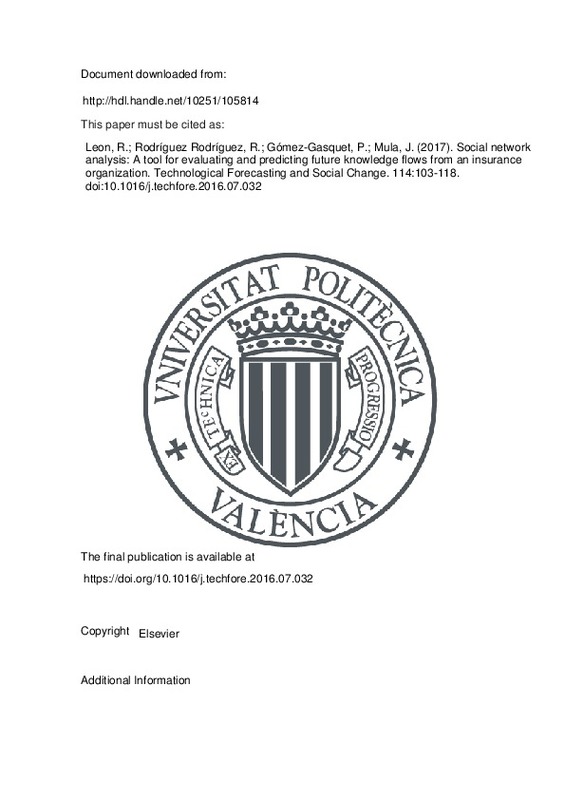JavaScript is disabled for your browser. Some features of this site may not work without it.
Buscar en RiuNet
Listar
Mi cuenta
Estadísticas
Ayuda RiuNet
Admin. UPV
Social network analysis: A tool for evaluating and predicting future knowledge flows from an insurance organization
Mostrar el registro sencillo del ítem
Ficheros en el ítem
| dc.contributor.author | Leon, Ramona-Diana
|
es_ES |
| dc.contributor.author | Rodríguez Rodríguez, Raúl
|
es_ES |
| dc.contributor.author | Gómez-Gasquet, Pedro
|
es_ES |
| dc.contributor.author | Mula, Josefa
|
es_ES |
| dc.date.accessioned | 2018-07-16T06:45:44Z | |
| dc.date.available | 2018-07-16T06:45:44Z | |
| dc.date.issued | 2017 | es_ES |
| dc.identifier.issn | 0040-1625 | es_ES |
| dc.identifier.uri | http://hdl.handle.net/10251/105814 | |
| dc.description.abstract | [EN] The paper aims to identify the individuals who influence the knowledge sharing processes from an internal social network and to forecast the future knowledge flows that may cross it. Exploratory research is employed, and a four-phase methodology is developed which combines a social network analysis with structural modeling. This is applied to the internal enterprise social network used by a British insurance company. The main results emphasize the most influential groups, their relationships, future knowledge flows, and the connection between the network's heterogeneity and structure, and employees' future knowledge sharing intention. These findings have both theoretical and practical implications. The theory is extended by proving that a social network analysis can be used as a tool for evaluating and predicting future knowledge flows. At the same time, a solution is offered to decision-makers so they will be able to: (i) identify the potential knowledge loss; (ii) determine leaders; (iii) establish who is going to act as a knowledge diffuser, by sharing what they know with their coworkers, and who is going to act as a knowledge repository, by focusing on acquiring increasingly more knowledge; (iv) identify the elements that influence employees' future knowledge sharing intention. (C) 2016 Elsevier Inc. All rights reserved. | es_ES |
| dc.description.sponsorship | "The research reported in this paper is supported by the European Commission for the project "Engaging in Knowledge Networking via an interactive 3D social Supplier Network (KNOWNET)" (FP7-PEOPLE-2013-IAPP 324408)". | es_ES |
| dc.language | Inglés | es_ES |
| dc.publisher | Elsevier | es_ES |
| dc.relation.ispartof | Technological Forecasting and Social Change | es_ES |
| dc.rights | Reserva de todos los derechos | es_ES |
| dc.subject | Knowledge sharing | es_ES |
| dc.subject | Future knowledge flows | es_ES |
| dc.subject | Social network analysis | es_ES |
| dc.subject | Strategic planning and implementation | es_ES |
| dc.subject | Insurance sector | es_ES |
| dc.subject.classification | ORGANIZACION DE EMPRESAS | es_ES |
| dc.title | Social network analysis: A tool for evaluating and predicting future knowledge flows from an insurance organization | es_ES |
| dc.type | Artículo | es_ES |
| dc.identifier.doi | 10.1016/j.techfore.2016.07.032 | es_ES |
| dc.relation.projectID | info:eu-repo/grantAgreement/EC/FP7/324408/EU/Engaging in Knowledge Networking via an interactive 3D Social Supplier Network/ | es_ES |
| dc.rights.accessRights | Abierto | es_ES |
| dc.contributor.affiliation | Universitat Politècnica de València. Departamento de Organización de Empresas - Departament d'Organització d'Empreses | es_ES |
| dc.description.bibliographicCitation | Leon, R.; Rodríguez Rodríguez, R.; Gómez-Gasquet, P.; Mula, J. (2017). Social network analysis: A tool for evaluating and predicting future knowledge flows from an insurance organization. Technological Forecasting and Social Change. 114:103-118. https://doi.org/10.1016/j.techfore.2016.07.032 | es_ES |
| dc.description.accrualMethod | S | es_ES |
| dc.relation.publisherversion | https://doi.org/10.1016/j.techfore.2016.07.032 | es_ES |
| dc.description.upvformatpinicio | 103 | es_ES |
| dc.description.upvformatpfin | 118 | es_ES |
| dc.type.version | info:eu-repo/semantics/publishedVersion | es_ES |
| dc.description.volume | 114 | es_ES |
| dc.relation.pasarela | S\326757 | es_ES |
| dc.contributor.funder | European Commission | es_ES |







![[Cerrado]](/themes/UPV/images/candado.png)

